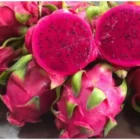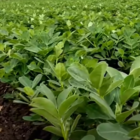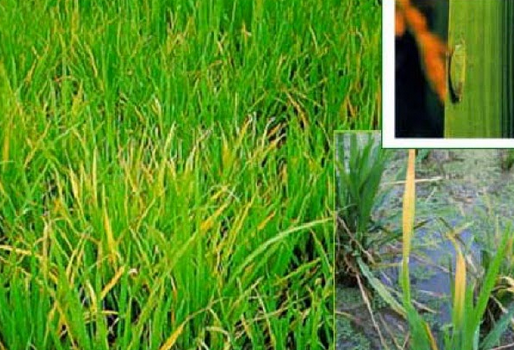
Rice Tungro Disease: Symptoms, Impact, and How to Protect Crops
| Disease | Rice Tungro |
|---|---|
| Hosts | Rice |
| Virus | Baciliform Virus (rtbv) and Rice Tungro Spherical Virus (rtsv) |
Rice Tungro disease is a viral disease that affects rice plants, primarily in Asia. It is caused by a complex of two viruses: Rice tungro spherical virus (RTSV) and Rice tungro bacilliform virus (RTBV). The disease is transmitted by an insect vector, the green leafhopper.
Infected plants show stunted growth, yellowing of leaves, and reduced grain production. The disease can cause significant yield losses, impacting the food security and livelihoods of rice farmers. Control measures include the use of resistant rice varieties, insecticide application, and cultural practices like clean planting materials and early planting to avoid peak insect activity.
Rice Tungro Disease Symptoms

Rice plants affected by Tungro disease exhibit several noticeable symptoms, which can be categorized as follows:
- Stunted Growth and Reduced Tillering:
- Infected plants tend to have stunted growth and reduced tillering, resulting in a smaller and less vigorous plant structure.
- Yellow or Orange-Yellow Leaves:
- The leaves of affected plants display a yellow or orange-yellow coloration, which is distinct from the healthy green color.
- Additionally, the leaves may develop rust-colored spots, further contributing to their discoloration.
- Leaf Discoloration:
- The discoloration usually starts from the tip of the leaf and gradually extends down to the blade or the lower portion of the leaf.
- This progressive yellowing or orange-yellowing of the leaves is a prominent characteristic of Tungro-infected plants.
- Delayed Flowering:
- Tungro disease in rice can cause a delay in the flowering process of rice plants.
- As a result, the panicles (flower clusters) are small in size and may not fully emerge from the leaf sheaths.
- Sterile or Partially Filled Grains:
- Most of the panicles on infected plants show signs of sterility or produce grains that are only partially filled.
- This reduces the overall grain yield and quality of the rice crop.
- Impact on the Vegetative Stage:
- Tungro virus affects all growth stages of the rice plant, particularly the vegetative stage.
- The virus interferes with the plant’s ability to grow and develop properly during this critical phase.
Identification of Rice Tungro Disease
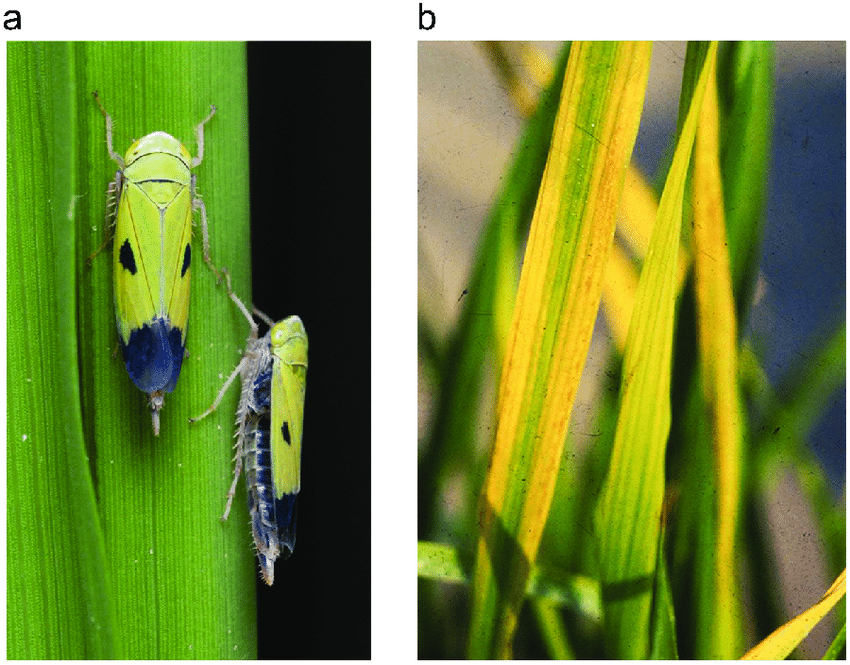
Rice Tungro disease can be identified through a combination of understanding its transmission, the characteristics of the viruses involved, and employing a special detection technique. Here’s how you can identify the presence of Tungro disease:
- Transmission and Virus Characteristics:
- Tungro virus disease is transmitted by leafhoppers, with the green leafhopper (Nephotettix virescens) being the most efficient vector.
- The disease complex involves two viruses: rice tungro bacilliform virus (RTBV) and rice tungro spherical virus (RTSV).
- RTBV cannot be transmitted by leafhoppers unless RTSV is present.
- Insects can acquire the virus from any part of the infected plant and transmit it to other plants.
- Virus Description:
- RTBV particles are rod-shaped, measuring 100-300 nm in length and 30-35 nm in width. They contain DNA of approximately 8.3 kb.
- RTSV particles are isometric and have a diameter of 30 nm. They consist of a polyadenylated single-stranded RNA of about 12 kb.
Special Detection Technique:
To identify Tungro-infected leaves, a special detection technique involving the use of iodine can be employed. Follow these steps:
- Sample Collection:
- Collect leaf samples specifically at 6 a.m., as the virus is most detectable at this time.
- Iodine Solution Immersion:
- Take the top 10 cm portion of the leaf and immerse it in a solution containing 2 g of iodine and 6 g of potassium iodide in 100 ml of water for 15 minutes.
- Alternatively, you can use a solution of 10 ml of tincture of iodine mixed with 140 ml of water for one hour.
- Washing and Examination:
- After the immersion, wash the leaf sample with water to remove excess solution.
- Upon examination, Tungro-infected leaves will exhibit dark blue streaks, providing a clear indication of the disease’s presence.
Factors Favoring Disease Development:
- Presence of virus sources (infected plants acting as reservoirs).
- Presence of the vector (leafhoppers).
- Age and susceptibility of host plants.
- Synchronization of the above three factors.
- Tungro virus can affect all growth stages of the rice plant, with particular impact during the vegetative stage.
Rice Tungro Disease Management
Preveting Method:
Izumi Guard:
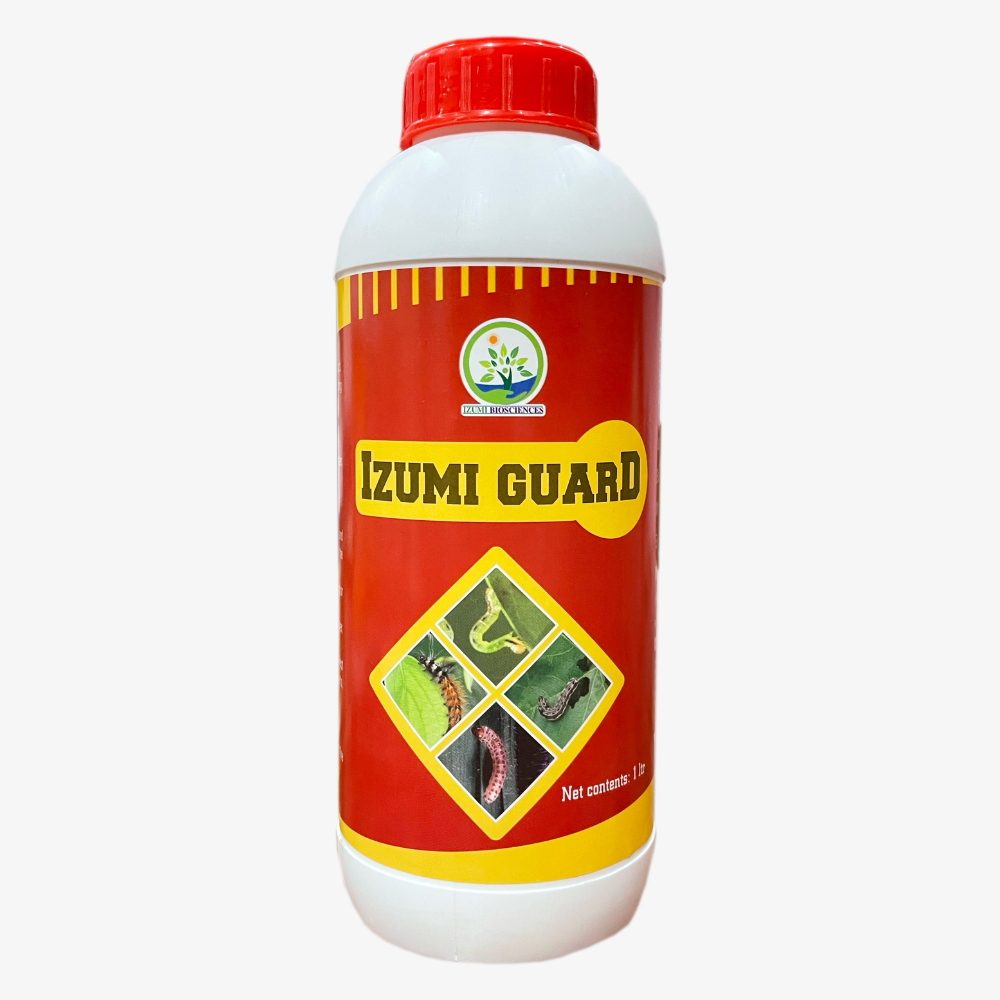
Izumi Guard-Liquid (Bio Insecticides)
Composition:
- 50% Extract of Streptomyces Rochei
- 30% Extract of Streptomyces Albus
- 20% Dissolving agents
Izumil:
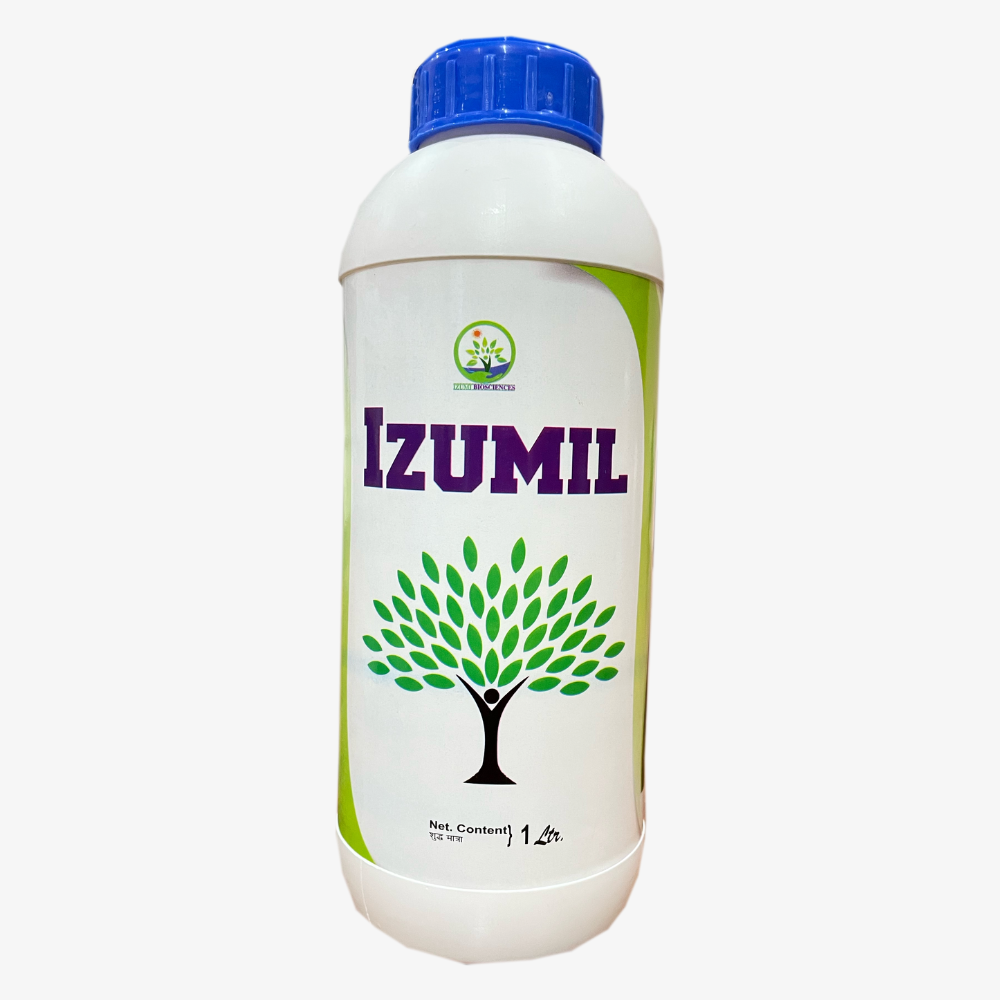
Izumil (Bio Fungicides and Bactericides)
Composition:
- 30% Extract of Streptomyces Griseus
- 40% Extract of Streptomyces Violaceus
Mode of Use:
- Dilute 3-5 ml of Izumi Guard and Izumil each in one litre of water.
- Prepare the solution on the same day of usage and ensure thorough mixing.
- Spray the diluted solution onto the plants, making sure to cover both sides of the leaves for optimal results.
- If using a power sprayer, double the dose of the solution.
- After usage, store the remaining solution in a sealed container and keep it in a cool place.
- In case of accidental contact with the eyes, rinse with plenty of water.
- The product maintains its stability for a period of 2-3 years.
Please note: The information provided is subject to change, and it is recommended to refer to the product packaging or consult a professional for specific usage instructions.
Cultural Method
- Plant Resistant Varieties:
- The most economical approach to managing Rice Tungro disease is by planting resistant rice varieties.
- Recommended resistant varieties include IR 36, IR 50, ADT 37, Ponmani, Co 45, Co 48, Surekha, Vikramarya, Bharani, IR 36, and white ponni.
- Adjust Planting Dates:
- By adjusting the planting dates, farmers can reduce the risk of Tungro disease of rice.
- It is advisable to plant during periods when the insect vectors are less active or the disease incidence is low.
- Fallow Period:
- Observing a fallow period of at least a month between rice crops can help eliminate potential hosts, viruses, and vectors of Tungro disease.
- During the fallow period, it is crucial to remove any infected plant material and practice proper sanitation to prevent disease carryover.
- Crop Rotation:
- In areas experiencing Rice Tungro disease epidemics, implementing crop rotation with pulses or oilseeds can break the disease cycle.
- This practice helps disrupt the buildup of disease-causing agents in the soil and reduces the risk of infection.
- Organic Amendments:
- Applying neem cake at a rate of 12.5 kg per 20 cents (approximately 0.2 hectares) of nursery area serves as a basal dose.
- Neem cake contains natural compounds that have insecticidal and antiviral properties, potentially reducing the incidence of Tungro disease.
- Field Ploughing and Harrowing:
- After harvest, promptly ploughing and harrowing the field helps destroy the stubbles and residues of the previous crop.
- This action minimizes the presence of tungro hosts and reduces the potential for disease transmission.
- Weed Host Control:
- It is essential to manage and control weed hosts, especially along bunds and field margins, as they can serve as reservoirs for Rice Tungro disease.
- Regular weeding and elimination of weed hosts contribute to disease control efforts.

